Tosoh Corporation is promoting activities related to safe and stable operations under its RC promotion system based on the Action Plan for Industrial Safety, a set of guidelines established by the Japan Petrochemical Industry Association in July 2013.
We recognize that ensuring employees’ safety and health and stable operations are the most important management issues, and based on our basic philosophy of environment, safety, and health and our action guidelines, which state that "safety takes precedence over everything else," we will continue to develop a variety of safety measures for strengthening the safety infrastructure and fostering a culture of safety to achieve zero accidents and zero lost work time injuries. Moreover, we will promote initiatives for business continuity plans (BCP) in preparation for natural disasters and other business risks.
Four accidents occurred at Tosoh in fiscal 2022.
In the event of an accident, Tosoh Corporation's Accident Countermeasures Committee investigates the cause and determines countermeasures, and holds a briefing session for the company and group companies in Japan to horizontally disseminate information on the accident with the aim of preventing recurrence.
Every year since fiscal 2013, the president of Tosoh has visited manufacturing sites of the Nanyo and Yokkaichi Complexes to hold direct dialogues with employees to share management's ideas on safety and on-site issues with employees, which serves to enhance employee motivation.
The president visited a total of 262 control rooms and offices over the 10-year period from 2012–2021, interacting with a total of more than 6,000 employees. The program was cancelled in fiscal 2021 in the interest of mitigating COVID-19 infections, but in fiscal 2022, it was conducted online and in person. Tosoh will continue its efforts to promote a culture of safety.
As a valuable reminder of the November 2011 explosion and fire at our No. 2 Vinyl Chloride Monomer Plant at the Nanyo Complex, we have erected the Safety Pledge monument and exhibit documents related to the accident. In addition, we have designated November 13 as Safety Day. On that day, we invite experts to address employees and host meetings and activities related to safety at the Nanyo and Yokkaichi Complexes. Through these activities, we hope to instill in all our employees the determination to promote and ensure company safety.
With the aim of making risk assessment more comprehensive, we are reevaluating our security equipment, focusing on the multiple layers of protection proposed by Professor Emeritus Kimihide Matsuyama of Kyushu University.1 In addition, the Abnormal Reaction Information System (ARIS) is now in operation.
At the Nanyo Complex, we verified the integrity of the third and final layer of protection (security, detoxification, and emergency shutdown equipment), and analyzed major events occurring in the security equipment using fault tree analysis (FTA), taking into account multiple factors in the base layer and the first and second layers.2 Verification work on the functional integrity of security equipment has been completed in the production departments and 47 potential hazards have been identified.
Moreover, events that are determined to have a high impact factor—as in the risk of explosions, fires, and leaks—are reevaluated by adding multiple event analysis and quantification of risk assessment indicators. And entering data into ARIS—which is now operational—for plants subject to high-pressure gas certification into ARIS has been completed. The results of the evaluation of reaction hazards are utilized in setting the key events of the FTA.
The Yokkaichi Complex is currently conducting a safety and disaster prevention risk assessment that incorporates perspectives on safety engineering and includes the verification of security equipment.
To achieve safe, stable, and efficient plant operation, we conduct a host of training programs in cooperation with related departments, reflecting the opinions of employees on site. Technical education includes hazard experience training.1 We also operate simulators and hands-on learning devices.2
In fiscal 2022, the company made improvements to bring the operability of practical training equipment and on-site operational equipment closer together to increase the value of hazard experience training. We further promoted other basic work safety training through the use of a safety training textbook that outlines tips for on-site tasks.
We are striving to enhance education and training to enable employees to acquire knowledge and skills related to safe and stable operations and to improve our on-site capabilities. Training regarding protective equipment also includes checking the use of equipment such as protective glasses, protective gloves, and helmets provided to individuals.
Accident Case Study Research
To prevent the recurrence of accidents and problems, it is important to investigate the causes based on principles, and to formulate and implement countermeasures that are permanent and not temporary. To uncover the root cause of problems, Tosoh looks into why a problem occurred and conducts detailed examinations and analyses of accident cases. In addition, we operate an accident and disaster information database to centrally manage accident cases. This facilitates our sharing of information and utilization of case studies for educational and training purposes.
Enhanced Safety
Activation of Digital Transformation
We are actively promoting the introduction of digital transformation (DX) to ensure plant safety and stable operations. Moreover, we are working to establish a systematic training program to quickly develop human resources such as data scientists familiar with digital technology, which is indispensable for advancing DX.
Implementation of Common Monitoring System for Complexes
We are sequentially introducing a common monitoring system for our production departments that utilizes big data accumulated in the distributed control system (DCS) for data collection. Abnormalities can be quickly detected on the monitoring screen, and operational guidance is displayed on a large monitor located in the control room, enabling unified, rapid decision making.
Introduction of Operational Support System
The company introduced an operational support system to visualize operational techniques and know-how in a flowchart format. It is used as a handbook for passing on operational techniques, education, and procedures. Furthermore, by automating operations through theory and principle that were previously driven by empirical knowledge, safe, stable, and correct operations can be ensured.
Introduction of Abnormality Prediction Detection System
Tosoh has put in place a machine learning-based prediction detection system for operational abnormalities. Machine learning the correlations across plant data under normal conditions, early detection of abnormalities can be made based on the discrepancy between the obtained normal model and reality. Machine learning is used not only for abnormality prediction detection, but also for quality prediction and productivity enhancement.
Electronic Logbook for Operational Handover
Conventional handwritten operation handover logbooks have been digitized to provide electronic data on work history, operation information, and knowledge. This allows all parties involved to share information when retrieving past operational data or for handover in a three-shift system, thereby improving efficiency. Going forward, we intend to optimize management by including conservation information.
Introduction of Tablets for On-Site Communication
We have introduced communication tablets at production facilities. The system is used to support the work of younger employees because information can be exchanged in real time between the work site and the control room through video and voice communication. At the Nanyo Complex, explosion-proof communication tablets have already been installed at the polyvinyl chloride (PVC), electrolysis, power, and aniline plants.
Non-explosion-proof communication tablets were introduced on a trial basis at the amine plant and the urethane 8M plant during routine repairs in the fall of September 2021, and at the carbon monoxide plant during routine maintenance. The objective was to reduce the need for equipment maintenance, and the company confirmed that it has resulted in reduced travel time and prompt sharing of information.
Introduction of Instrumentation Diagnostic Smart Valve System
The system continuously monitors valve operating conditions and utilizes analysis software to diagnose instrument malfunctions. The system is employed for early detection of equipment failures and optimal maintenance timing.
Introduction of Wireless Gas Detectors
Tosoh has installed wireless gas detectors at the boundaries of the complexes, and toxic gas concentrations are monitored in real time via an internal network system. Employing wireless gas detectors with built-in batteries that can detect gas leaks even during power outages caused by earthquakes has enabled Tosoh to quickly and reliably assess the impact of gas leaks outside of itscomplexes and respond rapidly.
Introduction of Wireless Vibration and Temperature Sensors
Wireless vibration and temperature sensors are installed on rotating equipment over a wide area within the complexes, and vibration and temperature are monitored in real time via an in-house network system for early detection of abnormalities in rotating equipment. We are investigating the potential for accumulating vibration and temperature data to realize high-performance diagnostics for abnormality prediction.
Introduction of Soft Sensors
Variables within processes such as component concentrations that are difficult to measure with ordinary measuring devices are automatically estimated in real time using machine learning. This makes possible continuous monitoring of variables, which leads to early detection of process fluctuations and proactive operational responses.
Introduction of Drones
The Nanyo Complex conducted tests of underwater and aerial drones during visual inspections, and confirmed that visibility was equivalent to that of visual inspections and that there were advantages over conventional inspections in terms of construction period, cost, and safety.
In the Yokkaichi area, companies and the government are collaborating in the promotion of initiatives related to the introduction of new technologies. Capitalizing on the characteristics of the region, we will introduce drones and train drone operators to be able to perform high-elevation exterior inspections of tanks and other facilities.
Installation of Gas Turbine Energy Management System
In conjunction with the construction of the gas turbine power plant, the company installed a system to collectively monitor the entire plant’s power and fuel balance and calculate the optimal amount of gas turbine power generation. Adjusting operation based on the results of these calculations leads to higher efficiency, which in turn leads to energy savings.
Strengthened Response to Cyberattacks
In the interest of preventing security incidents and maintaining stable operation, it is essential to strengthen security measures against cyberattacks. Therefore, in addition to the information system, a firewall has been installed on the control system network to which the DCS and other systems are connected, improving the ability to prevent both IT and OT (operational technology) computer virus infiltration.
Use of Cloud-Based Storage
We use a third-party cloud storage platform as a means of sharing information internally. It is also useful within the company for stimulating interdepartmental collaboration as well as that with external entities. The adoption of cloud-based storage also helps with business continuity planning (BCP) and the prevention of data leaks to external parties.
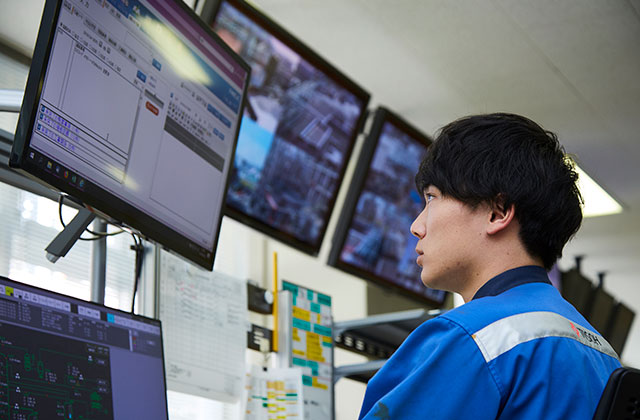
Electronic logbook for operational handover
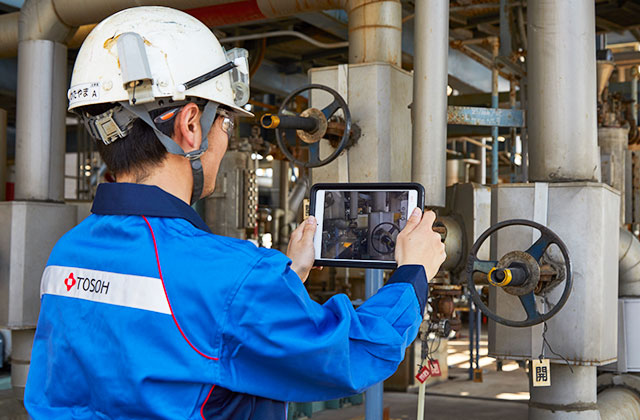
Tablet for on-site communication
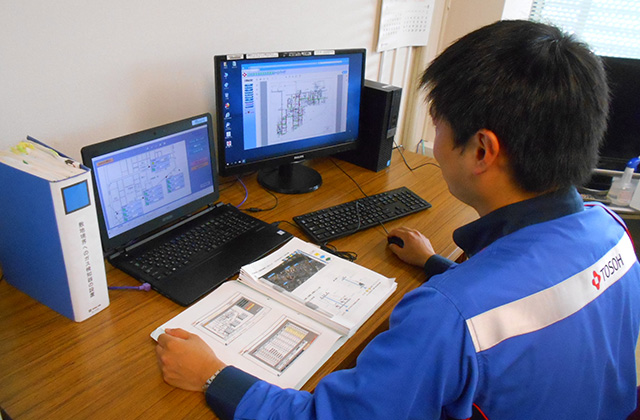
Monitoring with wireless gas detectors
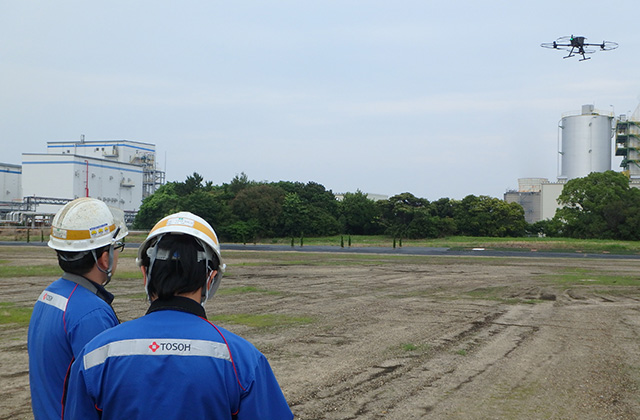
Drone-based visual inspection of elevated areas
Safety Technology Initiatives
To further improve the level of safety and promote process safety, the Safety Engineering team of the Technology Center is taking the lead in introducing safety technology, based mainly on safety engineering.
Advanced, Comprehensive Risk Assessment
We have adopted the concept of multilayer protection for process safety evaluation and have implemented numerous measures to prevent plant accidents to raise the level of safety. As a risk assessment method, we have established an advanced, comprehensive risk assessment system by adding FTA and abnormal reaction analysis to conventional methods, which are mainly based on hazard and operability studies (HAZOP).*
Training of Safety Technology Experts
We are developing a curriculum to train safety technology specialists. Moreover, beginning in fiscal 2022, as a means of cultivating experts, we have dispatched two staff members as contract researchers to universities with specialized safety engineering courses in fiscal 2022, and another two in fiscal 2023.
- Promotion of security equipment verification
- Operational support using machine learning and other methods
- Analysis of equipment materials for corrosion and other diagnoses
- Chemical and engineering technology education using practical training facilities
- Support for analysis of serious problems
*Hazard and operability study is a means of anticipating the consequences of events that impede operations and ensuring that the necessary preparations can be made.
Emergency Response
Disaster Preparedness Training
Tosoh conducts disaster drills at each of its complexes, laboratories, headquarters, and branch offices to raise employee awareness of their responsibilities and to equip them with the ability to respond to emergencies, thereby preparing them for unforeseen situations. Comprehensive disaster drills conducted together with the local government are open to local community associations, not only for hypothetical disasters such as leakage and fire, but also for evacuation drills for a tsunami caused by a large-scale earthquake. Moreover, the computerization of the entrance and exit gates has created a management system to control entry to the premises in the event of an emergency.
At each plant, emergency shutdown response, emergency response to oil spills including the deployment of oil fences, hose deployment and water discharge for initial firefighting, and training in wearing protective equipment such as air respirators are regularly conducted based on documented procedures to improve on-site response and prepare for emergencies. Furthermore, a public relations system is in place in the event of an accident, based on the Public Relations Manual for Residents in the Event of Petroleum Complex Disasters.
We have also prepared product-specific booklets on contingency plans and precautions to be taken in the event of an emergency in the region. And, every year, we invite media representatives to give mock press conferences and practice lectures to bolster risk communication skills.
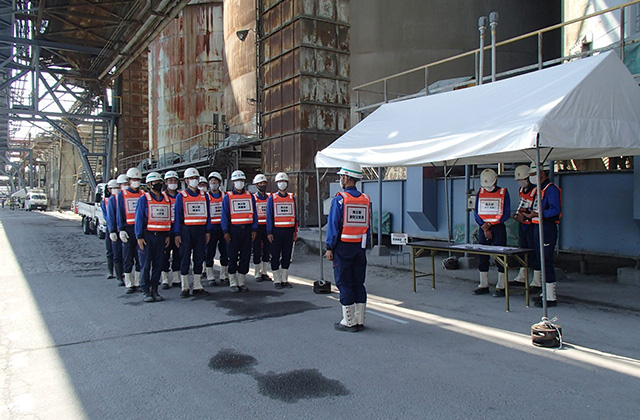
Comprehensive disaster drills in the first half of the year (Nanyo Complex)
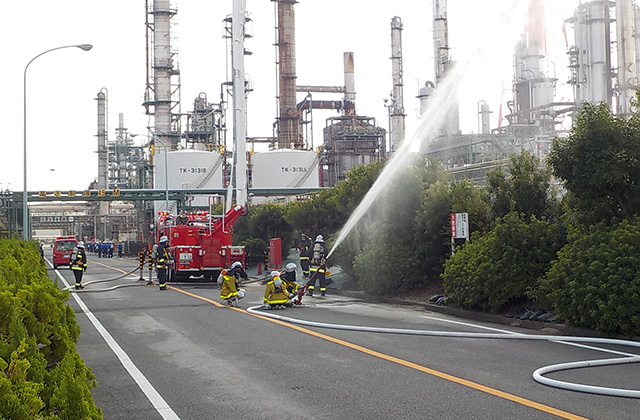
Comprehensive disaster preparedness training (Yokkaichi Complex)
| Name |
Month of
implementation |
Region of
implementation |
No. of
participants |
Details |
| Comprehensive disaster drills in the first half of the year |
July 2021 |
Nanyo |
56 |
Simultaneous drills for multiple locations in the event of a large-scale earthquake |
Comprehensive
disaster preparedness training |
October 2021 |
Yokkaichi |
600 |
Comprehensive disaster preparedness drills, tank yard fire, and Dai-ichi Kogyo Seiyaku disaster for all citizens |
Comprehensive
disaster preparedness training |
November 2021 |
Tokyo Research Center |
500 |
On-site training, spot call reports and in-flight training for all shifts in the workplace and fire department |
|
Comprehensive
disaster drills in the second half of the year |
November 2021 |
Headquarters/
Nanyo |
395 |
Disaster drill at the VCM tank in preparation for a large-scale earthquake, conducted jointly with the Shunan City Fire Department, in cooperation with headquarters and the Nanyo Complex. |
Comprehensive
disaster preparedness training |
November 2021 |
Yokkaichi |
200 |
Blind fire drills |
Fire drills at each
plant |
Conducted throughout the year |
Each complex |
- |
Plant emergency shutdown, water discharge, and protective equipment fitting training |
| Joint water discharge drill with the Disaster Preparedness Center |
Earthquake and Tsunami Countermeasures
In addition to evacuation and other response drills, we are also working on equipment handling. As earthquake countermeasures, we completed all seismic reinforcement work for high-pressure gas storage tanks at the Nanyo and Yokkaichi Complexes. In fiscal 2022, we made progress on seismic reinforcement work for control rooms and offices where employees are stationed. In terms of tsunami countermeasures, we are installing raised floor-type electrical equipment and on-site display of flood levels.
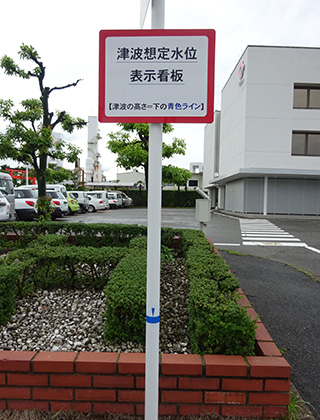
On-site display of flood levels (Yokkaichi Complex)
Business Continuity Plan Initiatives
Tosoh's first priority is to ensure the physical safety of employees under such circumstances, including widespread contingencies like the COVID-19 pandemic. At our complexes, we are sequentially taking steps to secure emergency power sources, safely shut down plants, and quickly restore operations in the event of a blackout caused by an infrastructure shutdown.
To ensure a stable supply of products to our customers, we are optimizing inventory and promoting purchasing from multiple sources, and are also reviewing and improving our disaster countermeasure regulations. In addition, due to our global business expansion, there are more opportunities for our employees to travel and be posted overseas. This increases the vulnerability of employees to global events such as wars, earthquakes, terrorism, riots, and infectious diseases. We are therefore implementing overseas crisis management measures to ensure the safety and well-being of our employees.
*A business continuity plan is an action plan to maintain operations as long as possible in the event of a disaster, accident, or other unforeseen event, and to recover and resume operations as soon as possible following an interruption.
External Evaluation
In December 2017, the Nanyo Complex reacquired certification as a Specific Accredited Completion and Safety Inspection Executor and as an Accredited Completion Inspection Executor, and underwent a certification renewal audit in August 2022. The Yokkaichi Plant renewed this certification in November 2021. Moreover, we regularly undergo external evaluations by the Japan Industrial Safety Competency Center (JSCC), a non-profit organization, to improve the security capabilities of each plant.
Logistics Safety
Basic Concept
Tosoh's products are delivered to customers primarily by truck and ship. Since accidents during transportation can cause delays in deliveries to customers, damage to facilities, and other issues, we are actively working to eliminate accidents.
List of RC Activity Target Results: Logistics Safety »
Initiatives to Eliminate Logistics Accidents
We are working to reduce the occurrence of accidents and improve safety awareness by implementing logistics-specific hazard prediction training and confirming its effectiveness through surveys.
i. Support for transportation equipment
We are also actively implementing hardware initiatives, such as launching an investigation into the prevention of contact accidents by installing work detection systems on forklifts.1
ii. Support for ship transport
For ships, we conducted voyage and operation diagnoses as part of education for logistics subcontractors (13 vessels were examined in fiscal 2022) and followed up on the results of the examinations.2 Patrols are conducted on each vessel to confirm management status.
iii. Support for truck transport
Based on past accidents, we have identified four priority items and are working to ensure that all employees are aware of them. The activities have been successful, and problems during truck delivery are on the decline. For truck transport, we created the Truck Transportation Safety Handbook and distributed it to transportation companies. We are also considering responding to requests from customers for improvement of truck delivery facilities.
1 A device that installs cameras and sensors on forklifts to detect approaching people and alerts them with lamps or buzzers.
2 A third-party instructor should be present during the actual voyage to confirm and evaluate the crew's judgment and knowledge